Kitchenaid KOST107ESS, KODE507EBL, KODE307ESS, KODE500ESS, KOSE500ESS Owner's Manual
...
User Guide
Built-In Electric Single and
Double Ovens
THANK YOU for purchasing this high-quality product. Register your built-in oven at www.kitchenaid.com. In Canada, register your built-in oven at www.kitchenaid.ca.
For future reference, please make a note of your product model and serial numbers. These can be found on the label located on the bottom edge of the control panel, right hand side.
Model Number______________________________________________ |
Serial Number_______________________________________________ |
Para una versión de estas instrucciones en español, visite www.kitchenaid.com.
Deberá tener a mano el número de modelo y de serie, que están ubicados en el marco del horno, detrás del lado derecho superior de la puerta del horno.
Table of Contents
BUILT-IN OVEN SAFETY................................................................. |
2 |
PARTS AND FEATURES................................................................. |
3 |
FEATURE GUIDE............................................................................. |
4 |
Electronic Oven Controls.............................................................. |
6 |
Display.......................................................................................... |
6 |
Start............................................................................................... |
6 |
Lower Cancel, Upper Cancel and Cancel.................................... |
6 |
Tones............................................................................................. |
7 |
Fahrenheit and Celsius................................................................. |
7 |
Tools ............................................................................................. |
7 |
Clock............................................................................................. |
7 |
Kitchen Timer................................................................................ |
7 |
Control Lock................................................................................. |
7 |
Oven Temperature Control........................................................... |
7 |
Sabbath Mode.............................................................................. |
8 |
OVEN USE....................................................................................... |
9 |
Aluminum Foil............................................................................... |
9 |
Oven Racks.................................................................................. |
9 |
Rack and Bakeware Positions...................................................... |
9 |
SatinGlide™ Roll-Out Extension Rack....................................... |
10 |
Bakeware.................................................................................... |
10 |
Meat Thermometer..................................................................... |
10 |
Oven Vent(s)................................................................................ |
11 |
Preheating and Oven Temperature............................................. |
11 |
Baking and Roasting.................................................................. |
11 |
Broiling........................................................................................ |
11 |
Convection.................................................................................. |
11 |
Convection Bake........................................................................ |
12 |
Convection Roast....................................................................... |
12 |
Convection Broil......................................................................... |
12 |
Proofing Bread............................................................................ |
12 |
Temperature Probe..................................................................... |
12 |
Timed Cooking............................................................................ |
13 |
High Temp Self-Cleaning Cycle.................................................. |
13 |
OVEN CARE................................................................................... |
13 |
General Cleaning........................................................................ |
14 |
Oven Lights................................................................................. |
15 |
Oven Door................................................................................... |
15 |
TROUBLESHOOTING................................................................... |
16 |
ASSISTANCE OR SERVICE.......................................................... |
17 |
In the U.S.A................................................................................. |
17 |
In Canada.................................................................................... |
17 |
ACCESSORIES.............................................................................. |
17 |
WARRANTY................................................................................... |
18 |
W10643471C
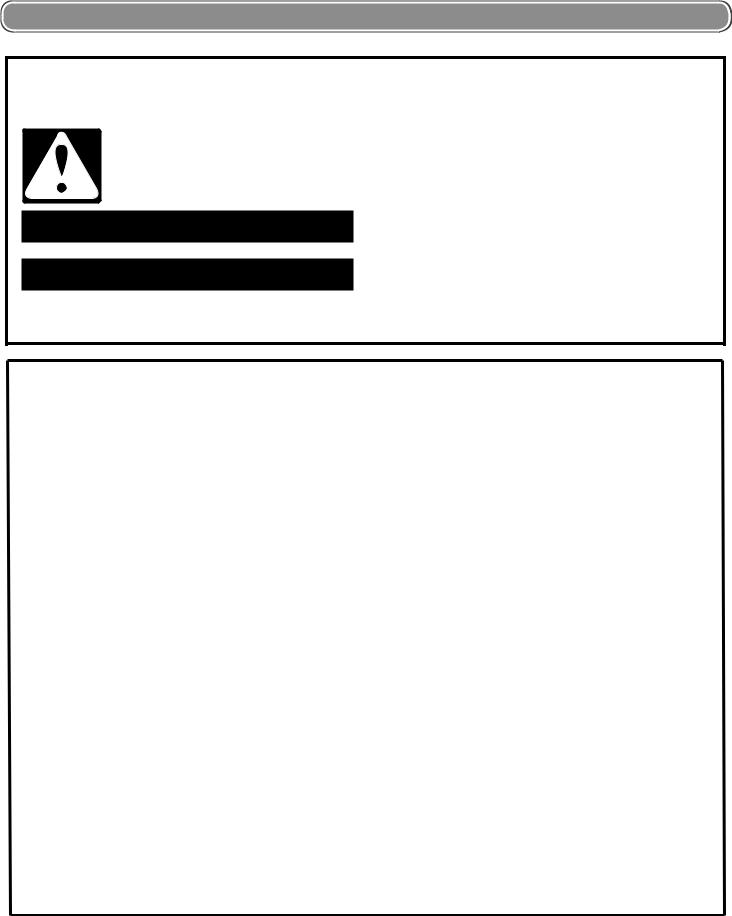
BUILT-IN OVEN SAFETY
Your safety and the safety of others are very important.
many important safety messages in this manual and on your appliance. Always read and obey all safety
safety alert symbol.
alerts you to potential hazards that can kill or hurt you and others.
messages will follow the safety alert symbol and either the word “DANGER” or “WARNING.”
mean:
 DANGER
DANGER  WARNING
WARNING
You can be killed or seriously injured if you don't immediately follow instructions.
You can be killed or seriously injured if you don't follow instructions.
All safety messages will tell you what the potential hazard is, tell you how to reduce the chance of injury, and tell you what can happen if the instructions are not followed.
IMPORTANT SAFETY INSTRUCTIONS
WARNING: To reduce the risk of fire, electrical shock, injury to persons, or damage when using the oven, follow basic precautions, including the following:
■Proper Installation – Be sure the oven is properly installed and grounded by a qualified technician.
■Never Use the Oven for Warming or Heating the Room.
■Do Not Leave Children Alone – Children should not be left alone or unattended in area where oven is in use. They should never be allowed to sit or stand on any part of the oven.
■Wear Proper Apparel – Loose-fitting or hanging garments should never be worn while using the oven.
■User Servicing – Do not repair or replace any part of the oven unless specifically recommended in the manual. All other servicing should be referred to a qualified technician.
■Storage in Oven – Flammable materials should not be stored in an oven.
■Do Not Use Water on Grease Fires – Smother fire or flame or use dry chemical or foam-type extinguisher.
■Use Only Dry Potholders – Moist or damp potholders on hot surfaces may result in burns from steam. Do not let potholder touch hot heating elements. Do not use a towel or other bulky cloth.
■Use Care When Opening Door – Let hot air or steam escape before removing or replacing food.
■Do Not Heat Unopened Food Containers – Build-up of pressure may cause container to burst and result in injury.
■Keep Oven Vent Ducts Unobstructed.
■Placement of Oven Racks – Always place oven racks in desired location while oven is cool. If rack must be moved while oven is hot, do not let potholder contact hot heating element in oven.
■DO NOT TOUCH HEATING ELEMENTS OR INTERIOR SURFACES OF OVEN – Heating elements may be hot even though they are dark in color. Interior surfaces of an oven become hot enough to cause burns. During and after use, do not touch, or let clothing or other flammable materials contact heating elements or interior surfaces of oven until they have had sufficient time to cool. Other surfaces of the oven may become hot enough to cause burns – among these surfaces are oven vent openings and surfaces near these openings, oven doors, and windows of oven doors.
For self-cleaning ovens:
■Do Not Clean Gasket – The gasket is essential for a good seal. Care should be taken not to rub, damage, or move the gasket.
■Do Not Use Oven Cleaners – No commercial oven cleaner or oven liner protective coating of any kind should be used in or around any part of the oven.
■Clean Only Parts Listed in Manual.
■Before Self-Cleaning the Oven – Remove broiler pan and other utensils.
For smart enabled ovens:
■Remote Operation – This appliance is configurable to allow remote operation at any time. Do not store any flammable materials or temperature sensitive items inside of the appliance.
SAVE THESE INSTRUCTIONS
2
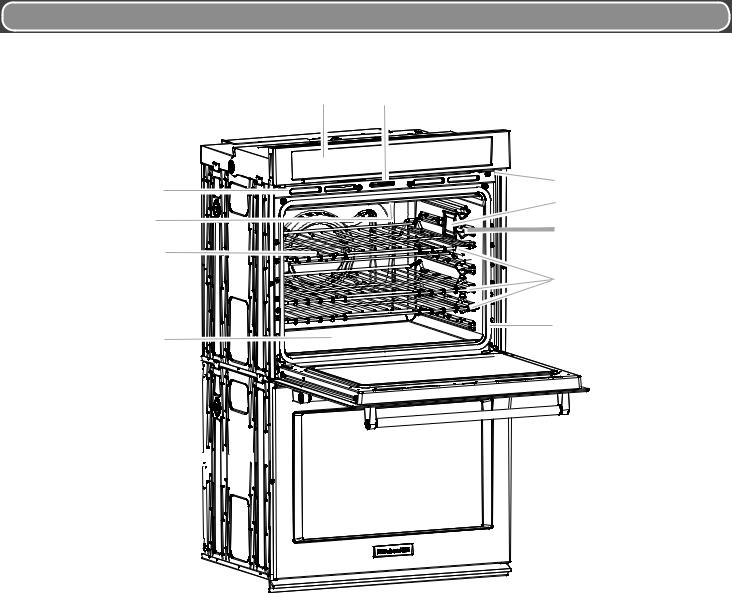
PARTS AND FEATURES
This manual covers different models. The oven you have purchased may have some or all of the items listed. The locations and appearances of the features shown here may not match those of your model.
A B,C
M |
D |
|
E |
||
|
||
L |
F |
|
|
||
K |
|
|
|
G |
|
J |
H |
|
|
I
A.Electronic oven control
B.Automatic oven light switch
C.Oven door lock latch
D.Model and serial number plate (on bottom edge of control panel, right hand side)
E.Oven lights
F.Temperature probe jack (oven with convection element and fan only)
G.Oven racks (roll-out racks available on select models only)
H.Gasket
I.Lower oven (on double oven models)
J.CleanBake™ bake element (hidden beneath floor panel)
K.Convection element and fan (in back panel)
L.Broil elements (not shown)
M.Oven vent
Parts and Features not shown
Temperature probe
3
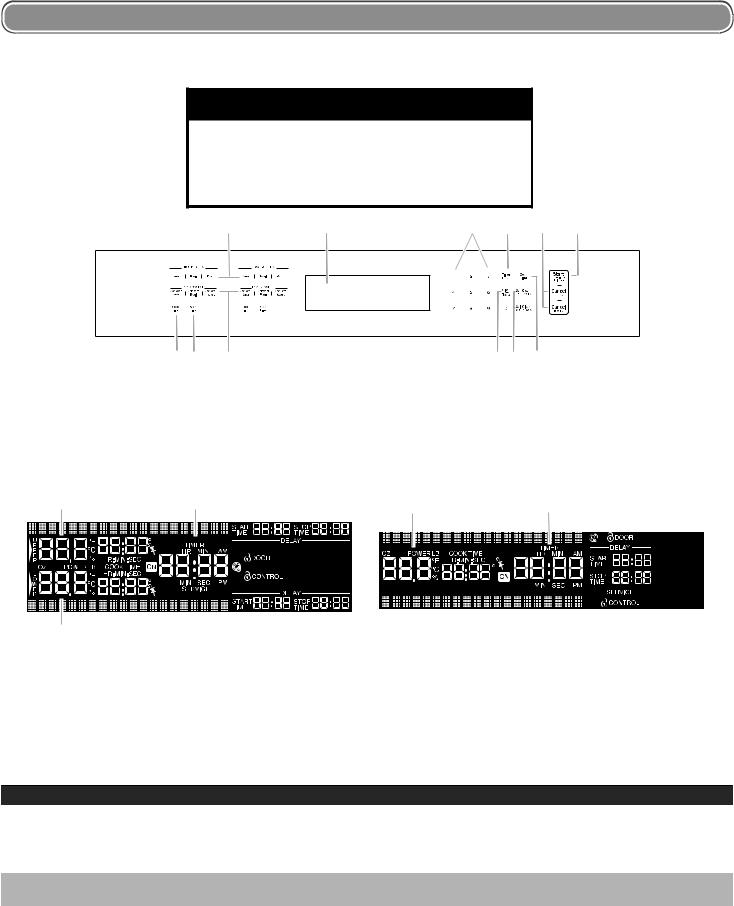
FEATURE GUIDE
This manual covers several models. Your model may have some or all of the items listed. Refer to this manual or the Product Help section of our website at www.kitchenaid.com for more detailed instructions. In Canada, refer to the Product Help Section at www.kitchenaid.ca.
 WARNING
WARNING
Food Poisoning Hazard
Do not let food sit in oven more than one hour before or after cooking.
Doing so can result in food poisoning or sickness.
A B C D E F
L K J
A.Oven settings
B.Oven display
C.Number keys
D.Kitchen timer
E.Upper and lower oven Cancel (double oven models) Cancel (single oven models)
F.Start/control lock
G.Oven light
H.Self clean
I H G
I.Clock/Tools
J.Convection cooking settings
K.Stop time
L.Cook time
A C A B
B
Double Oven Display
A.Upper oven cavity display
B.Lower oven cavity display
C.Time of day, timer display
Single Oven Display
A.Oven cavity display
B.Time of day, timer display
KEY |
FEATURE |
INSTRUCTIONS |
|
|
|
|
|
CLOCK/TOOLS |
Clock |
The Clock uses a 12 hour cycle. See the “Electronic Oven Controls” section. |
|
|
|
1. |
Touch CLOCK/TOOLS. |
|
|
2. |
Touch the “1” key to select Clock. Then touch the number keys to set the time of day. |
|
|
3. |
Touch START. |
|
|
|
|
CLOCK/TOOLS |
Settings |
Enables you to personalize the audible tones and oven operation to suit your needs. See the |
|
|
|
“Electronic Oven Controls” section. |
|
|
|
|
|
OVEN LIGHT |
Oven cavity |
The oven light is controlled by a key on the oven control panel. While the oven door is |
|
|
light |
closed, touch OVEN LIGHT to turn the light on and off. When the oven door is opened, the |
|
|
|
oven light will automatically come on. |
|
|
|
|
|
4

KEY |
FEATURE |
INSTRUCTIONS |
|
|
|
|
|
TIMER |
Oven timer |
The Timer can be set in hours or minutes up to 23 hours and 59 minutes. |
|
(SET/OFF) |
|
1. |
Touch TIMER SET/OFF. Touch TIMER SET/OFF again to switch between MIN/SEC, HR/ |
|
|
|
MIN, and OFF. If no action is taken, the control will continue to wait for a length of time |
|
|
|
to be entered. |
|
|
2. |
Touch the number keys to set the length of time. |
|
|
3. |
Touch TIMER SET/OFF. If the key is not touched, the control will continue to wait for |
|
|
|
SET/ START to be touched. When the set time ends, 4 chimes will continuously repeat |
|
|
|
until the Timer Set/Off key is touched. |
|
|
4. |
Touch TIMER SET/OFF anytime to cancel the Kitchen Timer or stop the reminder tones. |
|
|
|
If CANCEL is touched, the respective oven will turn off. However, the kitchen timer can |
|
|
|
be turned off only by using TIMER SET/OFF. |
|
|
|
|
START |
Cooking start |
The Start key begins any oven function. If Start is not touched within 5 minutes after |
|
|
|
touching a key, the function is canceled and the time of day is displayed. |
|
CANCEL UPPER |
Range function |
The Cancel keys stop any function for the appropriate oven except the Clock and Timer. |
|
CANCEL LOWER |
|
|
|
|
|
|
|
BAKE |
Baking and |
1. |
Touch Upper Oven or Lower Oven BAKE. Touch the number keys to enter a temperature |
(Upper and Lower |
roasting |
|
other than 350°F (177°C). The bake range can be set between 170°F and 550°F |
Oven) |
|
|
(77°C and 288°C). |
|
|
2. |
Touch START. “Lo” will appear on the oven display if the actual oven temperature is |
|
|
|
under 100°F (38°C), and “Preheating” will appear in the lower area of the display. When |
|
|
|
the actual oven temperature reaches 100°F (38°C), the oven display will begin displaying |
|
|
|
the temperature as it increases. When the set temperature is reached, if on, one tone will |
|
|
|
sound. |
|
|
3. |
Touch CANCEL for the selected oven when finished cooking. |
|
|
|
|
BROIL |
Broiling |
Close the door. |
|
|
|
1. |
Touch Upper or Lower BROIL. Touch the number keys to enter a temperature other than |
|
|
|
550°F (288°C). The broil range can be set between 450°F and 550°F (232°C and 288°C). |
|
|
2. |
Touch START. A long chime will sound. The set oven temperature will appear on the |
|
|
|
oven display until the oven is turned off. |
|
|
3. |
Touch CANCEL for the selected oven when finished cooking. |
|
|
|
|
EASY CONVECT |
Convect bake |
Before convection baking, position racks according to the “Rack And Bakeware Positions” |
|
BAKE |
|
section. |
|
|
|
1. |
Touch Upper or Lower CONVECT BAKE. |
|
|
2. |
Touch the number keys to choose whether or not to convert the recipe. |
|
|
3. |
If “1: Yes” has been selected, you will see a screen with “easy convect bake.” Then |
|
|
|
touch the number keys to enter a temperature. The convection bake range can be set |
|
|
|
between 170°F and 550°F (77°C and 288°C). The oven temperature will automatically |
|
|
|
be reduced by 25°F (14°C) for EasyConvect™ Bake, and the adjusted temperature will |
|
|
|
show on the display, but the cook time will not be adjusted. Then touch the number keys |
|
|
|
to enter a cook time. |
|
|
|
NOTE: If a temperature between 170°F and 194°F (77°C and 90°C) is entered, the |
|
|
|
display will show only 170°F (77°C) and not the reduced temperature. |
|
|
4. |
If “2: No” has been selected, Convect Bake will continue without conversion. Touch the |
|
|
|
“1” number key to use Rapid Preheat or “2” to continue without Rapid Preheat. Then |
|
|
|
touch the number keys to enter a temperature. |
|
|
|
NOTE: Rapid Preheat Convect Bake should only be used for 1-rack baking. |
|
|
5. |
Touch START. “Lo” will appear on the oven display if the actual oven temperature is |
|
|
|
under 100°F (38°C), and “Preheating” will appear in the lower area of the display. When |
|
|
|
the actual oven temperature reaches 100°F (38°C), the oven display will show the oven |
|
|
|
temperature increasing. When the set temperature is reached, if on, 1 chime will sound. |
|
|
6. |
Touch CANCEL for the selected oven when finished cooking. |
|
|
|
|
EASY CONVECT |
Convect roast |
1. |
Touch Upper or Lower CONVECT ROAST. |
ROAST |
|
2. |
Touch the number keys to choose whether or not to convert the recipe. |
|
|
||
|
|
3. |
If “1: Yes” has been selected, you will see a screen with “easy convect roast.” Touch the |
|
|
|
number keys to enter a temperature. The convection roast range can be set between |
|
|
|
170°F and 550°F (77°C and 288°C). Touch the number keys to enter a cook time. The |
|
|
|
cook time will automatically be adjusted to 80% of the time entered, and the adjusted |
|
|
|
cook time will appear on the display, but temperature will not be adjusted. |
|
|
4. |
If “2: No” has been selected, Convect Roast will continue without conversion. Touch the |
|
|
|
number keys to enter a temperature. |
|
|
5. |
Touch START. A long chime will sound. The set oven temperature will appear on the |
|
|
|
oven display until the oven is turned off. |
|
|
6. |
Touch CANCEL for the selected oven when finished cooking. |
|
|
|
|
5

KEY |
FEATURE |
INSTRUCTIONS |
|
|
|
|
|
CONVECT MODE |
Convect broil |
Close the door. |
|
|
|
1. |
Touch Upper or Lower CONVECT BROIL. Touch the number keys to enter a temperature |
|
|
|
other than 550°F (288°C). The convection broil range can be set between 450°F and |
|
|
|
550°F (232°C and 288°C). |
|
|
2. |
Touch START. The set oven temperature will appear on the oven display until oven is |
|
|
|
turned off. |
|
|
3. |
Touch CANCEL for the selected oven when finished cooking. |
|
|
|
|
PROOF |
Proofing bread |
1. |
Touch Upper or Lower PROOF. Display will show 100°F (38°C). |
|
|
2. |
Touch START. Let dough rise until nearly doubled in size, and then check at |
|
|
|
20 to 25 minutes. Proofing time may vary depending on dough type and quantity. |
|
|
3. |
Touch CANCEL for the selected oven when finished cooking. |
Refer to the “Proofing Bread” section for more information.
STOP TIME |
Delayed start |
The Stop Time key is used to enter the starting time for an oven function with a delayed |
|
|
start. Stop Time should not be used for foods such as breads and cakes because they may |
|
|
not bake properly. |
|
|
To set Cook Time or Stop Time, see the “Timed Cooking” section. |
|
|
|
COOK TIME |
Timed cooking |
Cook Time allows the oven to cook for a set length of time, and/or shut off automatically. |
|
|
To set Cook Time or Stop Time, see the “Timed Cooking” section. |
|
|
|
Electronic Oven Controls
A B C D E F
L K J
A.Oven settings
B.Oven display
C.Number keys
D.Kitchen timer
E.Upper and lower oven cancel (double oven models) Cancel (single oven models)
F.Start/control lock
G.Oven light
H.Self clean
I H G
I.Clock/Tools
J.Convection cooking settings
K.Stop time
L.Cook Time
Display
When power is first supplied to the oven, the timer display will flash “12:00”, and “Clock-Enter Time” will appear on the display. Enter the time by touching the number keys. Touch START to allow operation. To allow operation without setting a time, touch START or CANCEL.
Oven Display
When the oven(s) are in use, this display shows the oven temperature, heat source(s) and start time. On double oven models, this display will also show which oven is being set. The upper cavity symbol represents the upper oven; the lower cavity symbol represents the lower oven.
In addition, during Timed Cooking, this display shows a time countdown and the stop time (if entered).
Time of Day, Timer Display
When the oven(s) are not in use, this display shows the time of day or Timer countdown.
Start
The START key begins all oven functions except Sabbath Mode. If the Start key is not touched within 5 seconds after touching another key, “START?” will appear on the oven display as a reminder. If the Start key is not touched within 5 minutes after touching another key, the oven display will return to inactive mode and the programmed function will be canceled.
Lower Cancel, Upper Cancel and Cancel
The Lower Cancel, Upper Cancel and Cancel keys stop their respective oven functions except for the Clock, Kitchen Timer, and Control Lock. The oven cooling fan(s) may continue to operate even after an oven function has been canceled or completed, depending on the oven temperature.
6
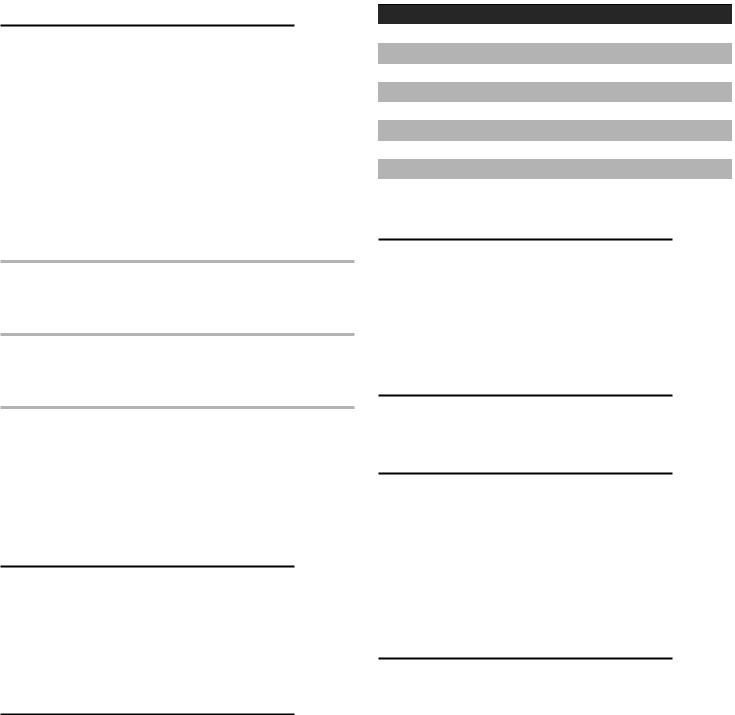
Tones
Tones are audible signals, indicating the following:
One beep
■■ Valid key touch
■■ Function has been entered
One chime
Preheat cycle has been completed
Three beeps
Invalid key touch
Three chimes
End of a cooking cycle
Four chimes
When timer reaches zero
Includes using the Kitchen Timer for functions other than cooking.
Tone Volume
The volume is preset at low, but can be changed to high.
To Change: Touch TOOLS, and then “4” to toggle volume between high and low settings.
All Tones
All tones are preset on, but can be turned off.
To Turn Off/On: Touch TOOLS, and then “3” to toggle tones between on/off settings.
End-of-Cycle and Reminder Tones
The Timed Cooking end-of-cycle and reminder tones are preset on, but can be turned off. If all tones have been turned off, the end-of-cycle and reminder tones cannot be independently turned on.
To Turn Off/On: Touch TOOLS, and then “5” to turn On. Touch TOOLS, and then “5” to turn Off.
NOTE: Turning off this reminder tone does not turn off the Kitchen Timer tone.
Fahrenheit and Celsius
The temperature is preset in Fahrenheit; however it can be changed to Celsius.
To Change: Touch TOOLS, and then “2” to toggle temperature between Fahrenheit and Celsius settings.
When the temperature is in Fahrenheit, “°F” follows the oven temperature.
When the temperature is in Celsius, “°C” follows the oven temperature.
Tools
The Tools selection key allows you access to 9 hidden functions within the Electronic Oven Control. These hidden functions allow you to set the clock, change the oven temperature between Fahrenheit and Celsius, turn the audible signals and prompts on and off, and adjust the oven calibration, change the language, and turn on the Demo Mode.
The Sabbath Mode is also set using the Tools selection key.
To Use: Touch CLOCK/TOOLS. The oven display will scroll through the various tools, starting at “1” and ending automatically at “9.” You can also touch the Tools key repeatedly to manually scroll through the list of tools.
TOOLS |
HIDDEN FUNCTION |
|
|
1 |
Clock |
|
|
2 |
Fahrenheit and Celsius conversion |
|
|
3 |
Sound On/Off |
|
|
4 |
Sound High/Low |
|
|
5 |
End tone On/Off |
|
|
6 |
Calibration |
|
|
7 |
Sabbath |
|
|
8 |
Language |
|
|
9 |
Demo Mode |
|
|
Clock
This is a 12 hour clock. Before setting, make sure the oven(s), Kitchen Timer, and Timed Cooking are off.
To Set:
1.Touch CLOCK/TOOLS.
2.Touch the “1” key.
3.Select Clock, and then touch the number keys to set the time of day.
4.Touch START.
Kitchen Timer
The Kitchen Timer can be set in minutes and seconds or hours and minutes, and counts down the set time.
NOTE: The Kitchen Timer does not start or stop the oven.
Control Lock
The Control Lock shuts down the control panel keys to avoid unintended use of the oven(s). The Control Lock will remain set after a power failure, if set before the power failure occurs. When the control is locked, only the Start, Timer Set/Off and Oven Light keys will function.
The Control Lock is preset unlocked, but can be locked.
To Lock Control: Touch and hold START for approximately
3 seconds, until “Control Locked” appears on the lower text line and a lock icon appears in the display.
To Unlock Control: Repeat to unlock. “Control Unlocked” appears on the lower text line and the lock icon will be removed.
Oven Temperature Control
IMPORTANT: Do not use a thermometer to measure the oven temperature. Elements will cycle on and off as needed to maintain a consistent temperature but may run slightly hot or cool at any point in time due to this cycling. Opening the oven door will affect cycling of the elements and impact the temperature.
The oven provides accurate temperatures and has been thoroughly tested at the factory. However, it may cook faster or slower than your previous oven, causing baking or browning differences. If necessary, the temperature calibration can be adjusted in either Fahrenheit or Celsius.
On double ovens, the upper oven and the lower oven can each be calibrated independently.
A minus sign means the oven will be cooler by the displayed amount. The absence of a minus sign means the oven will be warmer by the displayed amount. Use the following chart as a guide.
NOTE: The oven display will continue to show the original set temperature and will not reflect the calibration offset. For example, if set to 350° (177°C) and calibrated to -20, the display will continue to show 350° (177°C).
7
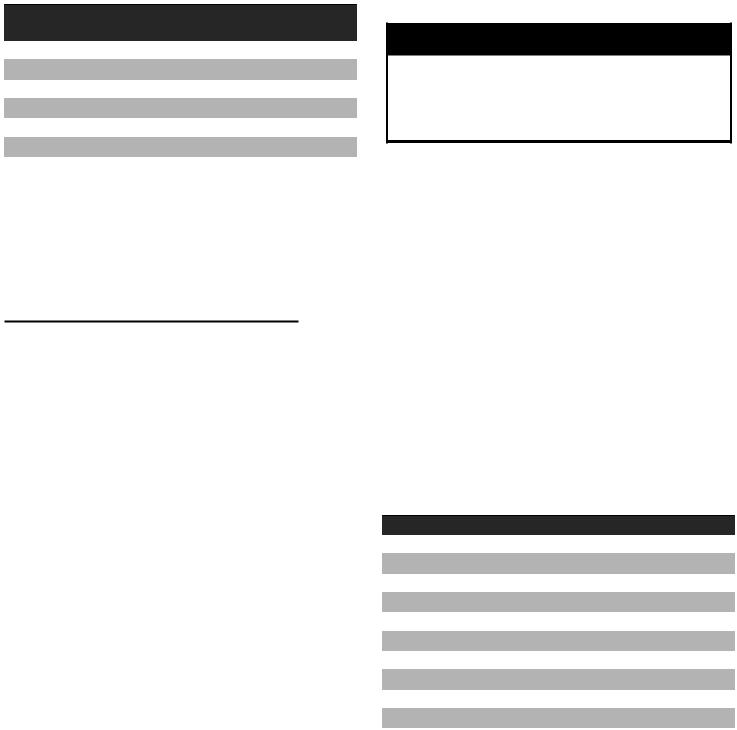
ADJUSTMENT °F |
COOKS FOOD |
(AUTOMATIC °C CHANGE) |
|
|
|
10°F (6°C) |
...a little more |
|
|
20°F (12°C) |
...moderately more |
|
|
30°F (18°C) |
...much more |
|
|
0°F (0°C) |
default setting |
|
|
-10°F (-6°C) |
...a little less |
|
|
-20°F (-12°C) |
...moderately less |
|
|
-30°F (-18°C) |
...much less |
|
|
To Adjust Oven Temperature Calibration:
1.Touch TOOLS, and then “6” to set the calibration.
2.Touch the “1” key to select the upper oven or the “2” key to select the lower oven.
Each oven calibration can be independently set.
3.Touch “3” to increase and “6” to decrease the temperature.
4.Touch START to end calibration.
Sabbath Mode
The Sabbath Mode sets the oven(s) to remain on in a bake setting until turned off. A timed Sabbath Mode can also be set to keep the oven on for only part of the Sabbath.
When the Sabbath Mode is set, the allowed keys are: the number keys, Start, Tools (to disable only), and Cancel. The display will scroll information on selecting the desired oven temperature.
When the oven door is opened or closed, the oven light will not turn on or off, and the heating elements will not turn on or off immediately.
If a power failure occurs when the Sabbath Mode is set, the oven(s) will remain in Sabbath Mode but will no longer be actively cooking. The “ON” indicator will no longer be lit. Touch Upper or Lower CANCEL to return to normal operating mode (non-Sabbath Mode, not cooking).
To Enable:
Before the Sabbath Mode can be regularly set, the oven(s) must first be enabled with a one time only setup. On double oven models, the following step will enable both ovens.
1.Touch CLOCK/TOOLS, and then touch number key “7.” “SABBATH MODE ON” will appear on the oven display for approximately 5 seconds.
To Disable:
The oven(s) can be disabled of the ability to set the Sabbath Mode by repeating the previous steps. See the “To Enable” section. When the oven(s) is disabled, “SABBATH MODE OFF” will appear on the display and remain on for approximately 5 seconds.
The Sabbath Mode cannot be regularly set until re-enabled. On double oven models, these steps will disable both ovens.
To Regularly Set, Untimed to Activate:
Sabbath Mode must be enabled before starting the Bake cycle. See the “To Enable” section.
1.Touch Upper or Lower BAKE.
Touch the number keys to enter a temperature other than 350°F (177°C). The bake range can be set between 170°F and 550°F (77°C and 288°C).
2.Touch START.
3.Touch CLOCK/TOOLS, and then number key “7.” “SABBATH MODE” will appear on the oven display.
To Regularly Set, Timed:
 WARNING
WARNING
Food Poisoning Hazard
Do not let food sit in oven more than one hour before or after cooking.
Doing so can result in food poisoning or sickness.
Sabbath Mode must be enabled before starting the Bake cycle. See the “To Enable” section.
1.Touch Upper or Lower BAKE.
Touch the number keys to enter a temperature other than 350°F (177°C). The bake range can be set between 170°F and 550°F (77°C and 288°C).
2.Touch COOK TIME.
3.Touch the number keys to enter the length of Sabbath Mode time, up to 11 hours 59 minutes.
4.Touch START. The oven will begin a timed bake cycle.
5.Touch CLOCK/TOOLS, and then touch number key “7.” “SABBATH MODE” will appear on the oven display.
The start time and stop time will appear on the lower oven display.
6.When the stop time is reached, the oven will automatically turn off. The oven control will remain in Sabbath Mode until the Cancel button is touched.
Temperature Change
The oven temperature can be changed when the oven(s) are in the Sabbath Mode. No tones will sound, and the display will not change. The heating elements will not turn on or off for a random time, anywhere from 16 to 24 seconds. It may take up to one-half hour for the oven to change temperature.
Number keys “1” through “0” represent temperatures. Use the following chart as a guide.
NUMBER KEY |
OVEN TEMPERATURE |
|
|
1 |
170°F (76°C) |
|
|
2 |
200°F (93°C) |
|
|
3 |
225°F (107°C) |
|
|
4 |
250°F (121°C) |
|
|
5 |
300°F (148°C) |
|
|
6 |
325°F (162°C) |
|
|
7 |
350°F (176°C) |
|
|
8 |
375°F (190°C) |
|
|
9 |
400°F (204°C) |
|
|
0 |
450°F (232°C) |
|
|
To Change Temperature:
Initially, on double ovens, the cavities can be set for independent temperatures. However, once Sabbath Mode is running, if
the temperature is changed, both cavities will use the new temperature.
1.Touch the number key from the chart.
2.Touch START.
8
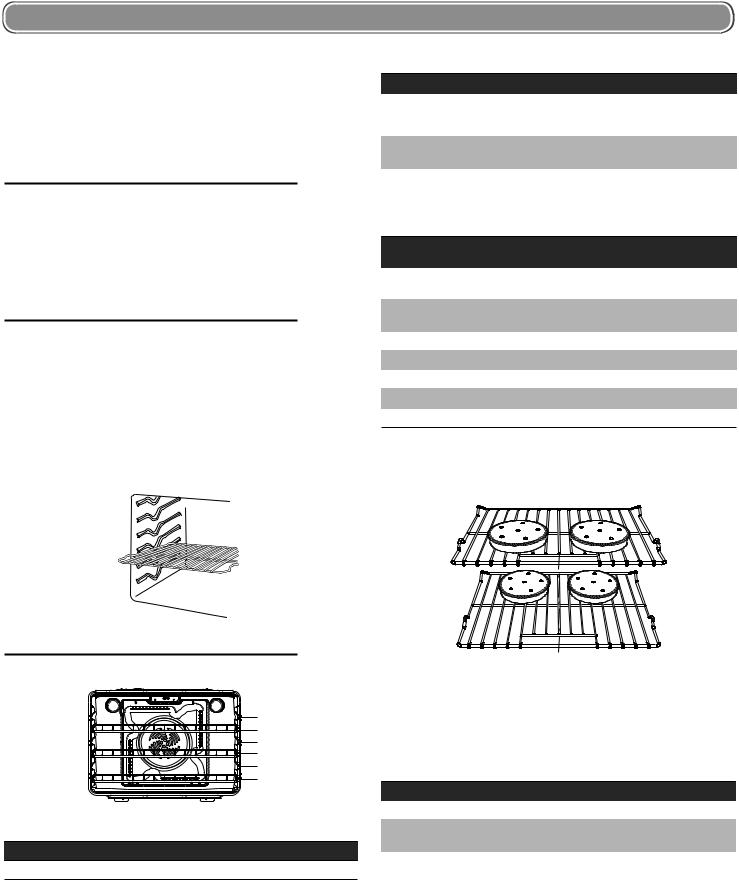
OVEN USE
Odors and smoke are normal when the oven is used the first few times, or when it is heavily soiled.
During oven use, the heating elements will not remain on, but will cycle on and off throughout oven operation.
IMPORTANT: The health of some birds is extremely sensitive to the fumes given off. Exposure to the fumes may result in death to certain birds. Always move birds to another closed and wellventilated room.
Aluminum Foil
IMPORTANT: To avoid permanent damage to the oven bottom finish, do not line the oven bottom with any type of foil or liner.
■■ For best cooking results, do not cover entire rack with foil because air must be able to move freely.
■■ To catch spills, place foil on rack below dish. Make sure foil is at least 1/2" (1.3 cm) larger than the dish and that it is turned up at the edges.
Oven Racks
IMPORTANT: To avoid permanent damage to the porcelain finish, do not place food or bakeware directly on the oven door or bottom.
Racks
■■ Position racks before turning on the oven.
■■ Do not position racks with bakeware on them.
■■ Make sure racks are level.
To move a rack, pull it out to the stop position, raise the front edge, then lift out. Use the following illustration and charts as guides.
Rack and Bakeware Positions
Rack Positions - Upper And Lower Oven
|
6 |
|
5 |
|
4 |
|
3 |
|
2 |
|
1 |
Broiling |
|
FOOD |
RACK POSITION |
Most broiling |
6 |
For hamburger patties to have a well-seared exterior and a rare interior, use a flat rack in position 6. Side 1 should cook for approximately 3 minutes. Side 2 should cook for approximately
3 to 4 minutes. Expect a moderate degree of smoke when broiling.
Traditional Cooking
FOOD |
RACK POSITION |
|
|
Large roasts, turkeys, angel |
1 or 2 |
food, bundt cakes, quick |
|
breads, pies |
|
Yeast breads, casseroles, meat |
2 |
and poultry |
|
|
|
Cookies, biscuits, muffins, |
2 or 3 when single-rack |
cakes |
baking; 2f and 5f when multi- |
|
rack baking |
Convection Cooking
OVEN SETTING |
NUMBER OF |
RACK POSITION(S) |
|
RACKS USED |
|
Rapid Preheat |
1 |
3 |
Bake |
|
|
|
|
|
Rapid Preheat |
1 |
3 |
Convection Bake |
|
|
|
|
|
Convection Bake |
1 |
1, 2 or 3 |
|
|
|
Convection Bake |
2 |
2 and 5 |
|
|
|
Convection Bake |
3 |
1, 3 and 5 |
|
|
|
Convection Roast |
1 |
1 or 2 |
|
|
|
Convection Broil |
1 |
4, 5 or 6 |
Baking Cakes on 2 Racks
For best results when baking cakes on 2 racks, use the Bake function and flat racks in positions 2 and 5. Place the cakes on the racks as shown. Keep at least 2 inches of space between the front of the racks and the front of the cakes.
Baking Cookies on 2 Racks
For best results when baking cookies on 2 racks, use the Convect Bake function and place flat racks in positions 2 and 5.
Bakeware
To cook food evenly, hot air must be able to circulate. For best results, allow 2" (5 cm) of space around bakeware and oven walls. Use the following chart as a guide.
NUMBER OF PAN(S) |
POSITION ON RACK |
|
|
1 |
Center of rack. |
|
|
2 |
Side by side or slightly |
|
staggered. |
|
|
3 or 4 |
See the rack position graphics |
|
in this section for pan |
|
placement recommendations. |
9
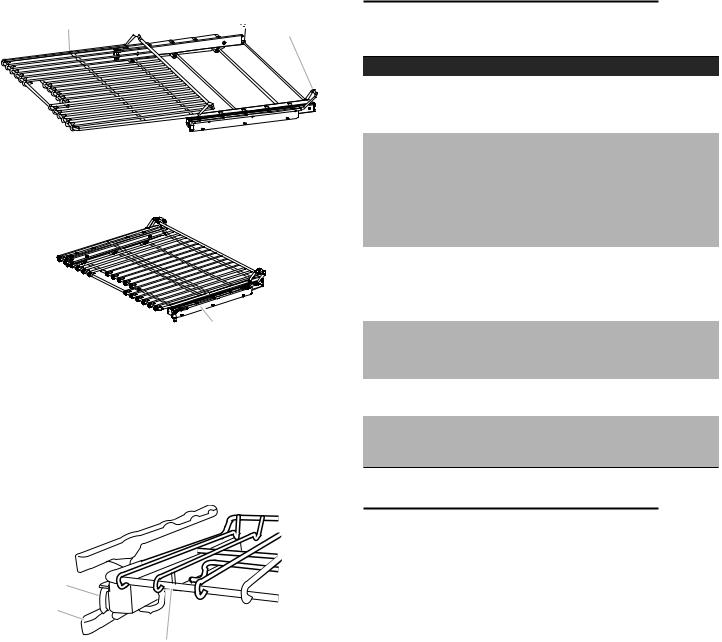
SatinGlide™ Roll-Out Extension Rack
The SatinGlide™ roll-out extension rack allows easy access to position and remove food in the oven. It can be used in rack positions 1 through 6.
Open Position
A 



 B
B
A.SatinGlide™ roll-out extension rack
B.Sliding shelf
Closed and Engaged Position
A 
B
A.SatinGlide™ roll-out extension rack
B.Sliding shelf
To Remove SatinGlide™ Roll-Out Extension Rack:
1.Slide the rack in completely so that it is closed and engaged with the sliding shelf.
2.Using 2 hands, lift up on the front edge of the rack and push the sliding shelf to the back wall of the oven so that the front edge of the sliding shelf sits on the rack guides. The front edge of the rack and the sliding shelf should be higher than the back edge.
A
B
C
A.Sliding shelf
B.Rack guide
C.SatinGlide™ roll-out extension rack
3.Pull the rack and the sliding shelf out.
To Replace SatinGlide™ Roll-out Extension Rack
1.Using 2 hands, grasp the front of the closed rack and the sliding shelf. Place the closed rack and the sliding shelf on the rack guide.
2.Using 2 hands, lift up on the front edge of the rack and the sliding shelf together.
3.Slowly push the rack and the sliding shelf to the back of the oven until the back edge of the rack pulls over the end of the rack guide.
To avoid damage to the sliding shelves, do not place more than 25 lbs (11.4 kg) on the rack.
Do not clean the SatinGlide™ roll-out extension rack in a dishwasher. It may remove the rack’s lubricant and affect its ability to slide.
See the “General Cleaning” section for more information.
Bakeware
The bakeware material affects cooking results. Follow manufacturer’s recommendations and use the bakeware size recommended in the recipe. Use the following chart as a guide.
BAKEWARE/ RESULTS |
RECOMMENDATIONS |
||
|
|
|
|
Light colored aluminum |
■■ |
Use temperature and time |
|
■■ Light golden crusts |
|
recommended in recipe. |
|
|
|
||
■■ Even browning |
|
|
|
|
|
|
|
Dark aluminum and other |
■■ |
May need to reduce baking |
|
bakeware with dark, dull |
|
temperatures slightly. |
|
and/or nonstick finish |
■■ |
Use suggested baking time. |
|
■■ Brown, crisp crusts |
|||
■■ |
For pies, breads and |
||
|
|||
|
|
casseroles, use temperature |
|
|
|
recommended in recipe. |
|
|
■■ Place rack in center of oven. |
||
|
|
|
|
Insulated cookie sheets or |
■■ |
Follow rack recommendations |
|
baking pans |
|
in the “Position Racks and |
|
■■ Little or no bottom |
|
Bakeware” section. |
|
|
|
||
browning |
■■ |
May need to increase baking |
|
|
|
time. |
|
|
|
|
|
Stainless steel |
■■ |
May need to increase baking |
|
■■ Light, golden crusts |
|
time. |
|
|
|
||
■■ Uneven browning |
|
|
|
|
|
|
|
Stoneware/Baking stone |
■■ |
Follow manufacturer’s |
|
■■ Crisp crusts |
|
instructions. |
|
|
|
||
|
|
|
|
Ovenproof glassware, |
■■ |
May need to reduce baking |
|
ceramic glass or ceramic |
|
temperatures slightly. |
|
■■ Brown, crisp crusts
Meat Thermometer
Not all models have a temperature probe. On models without a temperature probe, use a meat thermometer to determine
whether meat, poultry and fish are cooked to the desired degree of doneness. The internal temperature, not appearance, should be used to determine doneness.
10

Oven Vent(s)
A 
B




















































C 
D 
E

















































F 
G 





Single and Double Oven |
Double Oven |
A. Control panel |
D. Upper oven |
B. Oven vent |
E. Oven vent |
C. Single oven or upper |
F. Lower oven |
double oven |
G. Bottom vent |
G. Bottom vent |
|
The oven vent(s) should not be blocked or covered since they allow the inlet of fresh air into the cooling system. Also, the bottom vent should not be blocked or covered since it allows the inlet of fresh air into the cooling system and the outlet of hot air from the cooling system. Blocking or covering vents will cause poor air circulation, affecting cooking, cleaning and cooling results.
Preheating and Oven Temperature
Preheating
When beginning a Bake or Convect Bake cycle, the oven begins preheating after Start is touched. The oven will take approximately 12 to 17 minutes to reach 350°F (177°C) with all of the oven racks provided with your oven inside the oven cavity. Higher temperatures will take longer to preheat. The preheat cycle rapidly increases the oven temperature. The actual oven temperature
will go above your set temperature to offset the heat lost when your oven door is opened to insert food. This ensures that when you place your food in the oven, the oven will begin at the proper temperature. Insert your food when the preheat tone sounds. Do not open the door during preheat until the tone sounds.
Oven Temperature
While in use, the oven elements will cycle on and off as needed to maintain a consistent temperature. They may run slightly hot or cool at any point in time due to this cycling. Opening the oven door while in use will release the hot air and cool the oven which could impact the cooking time and performance. It is
recommended to use the oven light to monitor cooking progress.
Baking and Roasting
IMPORTANT: The convection fan and convection element may operate during the Bake function to enhance performance and heat distribution.
The oven will take approximately 12 to 17 minutes to reach 350°F with all oven racks inside the oven cavity. The preheat cycle rapidly increases the temperature inside the oven cavity. Higher temperatures will take longer to preheat. Factors that impact preheat times include room temperature, oven temperature, and the number of racks. Unused oven racks can be removed prior to preheating your oven to help reduce preheat time. The actual oven temperature will go above the set temperature to offset the heat lost when the oven door is opened to insert food.
This ensures that the oven will begin at the proper temperature when you place food in the oven. Insert food when the preheat tone sounds. Do not open the door during preheat until the tone sounds.
During baking or roasting, the bake and broil elements will cycle on and off in intervals to maintain the oven temperature.
Depending on the model, if the oven door is opened during baking or roasting, the heating elements (bake and broil) will turn off approximately 30 seconds after the door is opened. They will turn on again approximately 30 seconds after the door is closed.
Broiling
Broiling uses direct radiant heat to cook food.
The element cycles on and off in intervals to maintain the oven temperature.
IMPORTANT: Close the door to ensure proper broiling temperature.
If the oven door is opened during broiling, the broil element will turn off in approximately 30 seconds. When the oven door is closed, the element will come back on approximately 30 seconds later.
■■ For best results, use a broiler pan and grid. It is designed to drain juices and help avoid spatter and smoke.
If you would like to purchase a Broiler Pan Kit, it may be ordered. See “Accessories” section to order.
■■ For proper draining, do not cover the grid with foil. The bottom of the broiler pan may be lined with aluminum foil for easier cleaning.
■■ Trim excess fat to reduce spattering. Slit the remaining fat on the edges to avoid curling.
■■ Pull out oven rack to stop position before turning or removing food. Use tongs to turn food to avoid the loss of juices. Very thin cuts of fish, poultry or meat may not need to be turned.
■■ After broiling, remove the pan from the oven when removing the food. Drippings will bake on the pan if left in the heated oven, making cleaning more difficult.
Convection
In a convection oven, the fan-circulated hot air distributes heat more evenly. This movement of hot air helps maintain a consistent temperature throughout the oven, cooking foods more evenly, while sealing in moisture.
Most foods, using convect baking mode, can be cooked by lowering cooking temperatures 25°F (14°C). The cooking time, can be shortened significantly when using Convect Roast, especially for large turkeys and roasts.
■■ It is important not to cover foods with lids or aluminum foil so that surface areas remain exposed to the circulating air, allowing browning and crisping.
■■ Keep heat loss to a minimum by opening the oven door only when necessary. It is recommended to use the oven light to monitor progress.
■■ Choose cookie sheets without sides and roasting pans with lower sides to allow air to move freely around the food.
■■ Test baked goods for doneness a few minutes before the minimum cooking time using a method such as a toothpick.
■■ Use a meat thermometer or the temperature probe to determine the doneness of meats and poultry. Check the temperature of pork and poultry in 2 or 3 places.
11

Convection Bake (on some models)
The convection element is hidden in the rear panel of the oven cavity, and assisted by the convection fan, provides balanced, efficient heating.
Convection baking can be used for baking delicate cakes and pastries, as well as foods on multiple racks. It is helpful to stagger items on the racks to allow a more even flow of heat. If the oven is full, extra cooking time may be needed.
When cooking an oven meal with several different types of foods, be sure to select recipes that require similar temperatures. Cookware should sit in the oven with at least 2" (5 cm) of space between the cookware and the sides of the oven.
During convection baking preheat, the convection element, broil element and the CleanBake™ element all heat the oven cavity. After preheat, the convection element, broil element and the CleanBake™ element will cycle on and off in intervals to maintain oven temperature, while the fan circulates the hot air.
If the oven door is opened during convection baking, the fan turns off immediately when the door is opened and turns on immediately when the door is closed. Convection, Bake and Broil elements will turn off approximately 30 seconds after the door is opened. They will turn on again approximately 30 seconds after the door is closed.
NOTE: It is normal for the convection fan to run during nonconvection cycles as well as during preheat.
■■ Reduce recipe temperature 25°F (14°C). The cook time may need to be reduced also.
To Convection Bake:
Before convection baking, position racks according to the “Rack and Bakeware Positions” section.
Convection Roast (on some models)
Convection roasting can be used for roasting meats and poultry. During convection roasting, the broil, convect, and CleanBake™ elements will cycle on and off in intervals to maintain oven temperature, while the fan circulates the hot air.
If the oven door is opened during convection roasting, the fan turns off immediately when the door is opened and turns on immediately when the door is closed. Bake, broil, and convect elements will turn off approximately 30 seconds after the door is opened. They will turn on again approximately 30 seconds after the door is closed.
NOTE: It is normal for the convection fan to run during nonconvection cycles as well as during preheat.
To Convection Roast
Before convection roasting, position racks according to the “Rack and Bakeware Positions” section. It is not necessary to wait for the oven to preheat before putting food in, unless recommended in the recipe.
Convection Broil (on some models)
During convection broiling, the broil element will cycle on and off in intervals to maintain oven temperature, while the fan circulates the hot air.
The temperature is preset at 550°F (288°C), but can be changed to a different temperature. Cooking times will vary depending on the rack position and temperature and may need to be adjusted.
If the oven door is opened during convection broiling, fan turns off immediately when the door is opened and turns on again immediately when the door is closed. Broil elements will turn off approximately 30 seconds after the door is opened. They will turn on again approximately 30 seconds after the door is closed.
NOTE: It is normal for the convection fan to run during nonconvection cycles as well as during preheat.
To Convection Broil
Allow the oven to preheat for 5 minutes. Position food on the unheated grid on the broiler pan, and then place it in the center of the oven rack with the longest side parallel to the door.
Proofing Bread
Proofing bread prepares dough for baking by activating the yeast. Proofing twice is recommended unless the recipe directs otherwise.
To Proof
Before first proofing, place dough in a lightly greased bowl and cover loosely with waxed paper or plastic wrap coated with shortening. Place on rack guide 2. See “Rack and Bakeware Positions” for diagram. Close door.
1.Touch Upper or Lower PROOF. Display will show 100°F (38°C).
2.Touch START.
Let dough rise until nearly doubled in size, and then check at 20 to 25 minutes. Proofing time may vary depending on dough type and quantity.
3.Touch CANCEL for the selected oven when finished proofing.
Before second proofing, shape dough, place in baking pan(s) and cover loosely. Follow same placement, and control steps above. Before baking, remove waxed paper or plastic wrap.
Temperature Probe
(single, upper and, on some models, lower oven)
The temperature probe accurately measures the internal temperature of meat, poultry and casseroles with liquid and should be used in determining the doneness of meat and poultry. The temperature probe should only be used with Bake, Convect Bake or Convect Roast.
Always unplug and remove the temperature probe from the oven when removing food.
To Use
Before using, insert the probe into the food item. (For meats, the probe tip should be located in the center of the thickest part of the meat and not into the fat or touching a bone). Place food in oven and connect the temperature probe to the jack. Keep probe as far away from heat source as possible. Close oven door.
NOTE: The temperature probe must be inserted into the food item before the mode is selected.
1.Touch the number keys to enter a probe temperature. The probe temperature is the desired internal temperature of the food when it is done. The temperature can be set between 110°F and 200°F (43°C and 93°C).
2.Touch Upper or Lower BAKE, CONVECT BAKE or CONVECT ROAST.
Touch number keys to enter an oven temperature other than the one displayed. The oven temperature is the temperature given in the recipe.
3.Touch START.
The set oven temperature will appear on the oven display throughout cooking.
“Lo” will appear as the probe temperature until the internal temperature of the food reaches 45°F (7°C). Then the display will show the temperature increasing.
When the set probe temperature is reached, the oven will shut off automatically and “Cooking Complete” will appear on the oven display.
If enabled, end-of-cycle tones will sound, then reminder tones will sound every minute.
4.Touch CANCEL for the selected oven, or open the oven door to clear the display and/or stop reminder tones.
5.Always unplug and remove the temperature probe from the oven when removing food. The probe symbol will remain lit in the display until the probe is unplugged.
To Change Probe Temperature During a Cooking Cycle
1.Touch a probe enabled cooking mode (Bake, Convect Bake, or Convect Roast).
2.Follow steps 1 through 5 in the “To Use” section.
12
